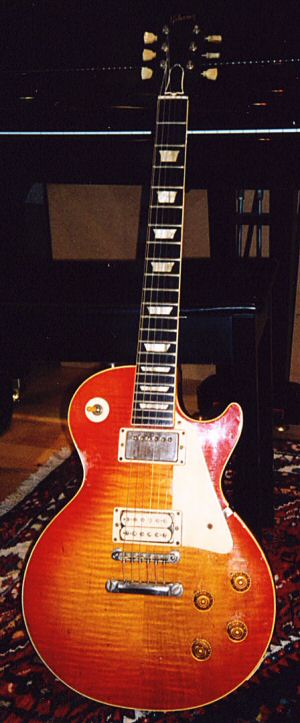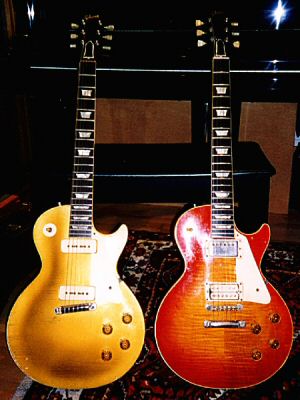
Ladies and gentlemen, Guitargonauts is proud to present the Holy Grail in the guitar collectors' bible - well, one of them at least - the most desirable and sought-after electric ever manufactured, Gibson's sunburst "flame-top" Les Paul Standard from the late 1950's. With tone and looks to die for, it has become a modern icon, its fabulous sound setting the bench mark for the rock guitar ethos we aspire to today.
Many thousands of Les Paul guitars had been shipped by Gibson during the 1950's, but towards the end of the decade sales had dwindled due to stiff competition from Fender and Gretsch. In 1958, the company decided to phase out its traditional "gold-top" finish in favour of a smart cherry-to-yellow sunburst, highlighting a two-piece figured maple top. The single-coil P90 pickups would be replaced by their new double-coil humbuckers. The result was arguably the sexiest-looking guitar of all time, but it was still not enough to lure the rock'n'rollers away from their twangy Fenders and their fancy paint jobs. Around 1,700 were produced over the following two and a half years, but many remained unsold and the model was re-designed with a new look for 1961, as the SG Les Paul. It would take a young musician from Surrey, England, to resurrect this dormant beast and reveal its splendour to an expectant audience.
When Eric Clapton saw his hero Freddy King holding a gold-coloured Les Paul guitar on an album sleeve back in 1965, he set off to look for one just like it. Second-hand examples were scarce in the U.K., but he soon found a sunburst 1958 model, fitted with humbucking pickups. As guitarist in John Mayall's Bluesbreakers, he discovered his new guitar had the perfect blues sound, brilliantly complemented by his own extraordinary technique. As Clapton's reputation spread he would create a revolution in the sound of the electric guitar, particularly following the arrival of the Marshall 100-watt amplifier which appeared purpose-built for further flattering the Les Paul's tone. Other gifted players soon followed suit; Jeff Beck, Peter Green, Mick Taylor, Mike Bloomfield, Paul Kossoff and later Jimmy Page would all take the guitar to their hearts, in turn influencing an entire generation of guitarists in the 1970's.

The saddest part of the story is that this guitar doesn't actually belong to me. It's the property of my talented friend Mr. Phil Thornalley, whose name you can find on at least two XTC albums, though better known nowadays as producer for mega-selling artists Natalie Imbruglia and Bryan Adams, among others. Phil's guitar dates to the early spring of 1960, is comfortably light in weight, and features a slightly slimmer neck than some of the earlier models - it's beautiful to play on. The bridge pickup cover has been removed, revealing two cream-coloured bobbins, an anomaly of the manufacturing period when the suppliers temporarily ran out of black plastic! The original machine heads have long gone, like so many replaced with Grovers in the 1970's, but currently features correct modern replacement tulip-button Klusons - way better. The cherry sunburst has faded beautifully over the years, the maple top a handsome display of stripes and curls that are a joy to behold.
Phil tells me his guitar can be heard "all over the new Bryan Adams, when the bugger finally comes out" - remember where you heard it first! My grateful thanks to Phil for allowing me to feature his fabulous prize and ..er.. good luck with the career.